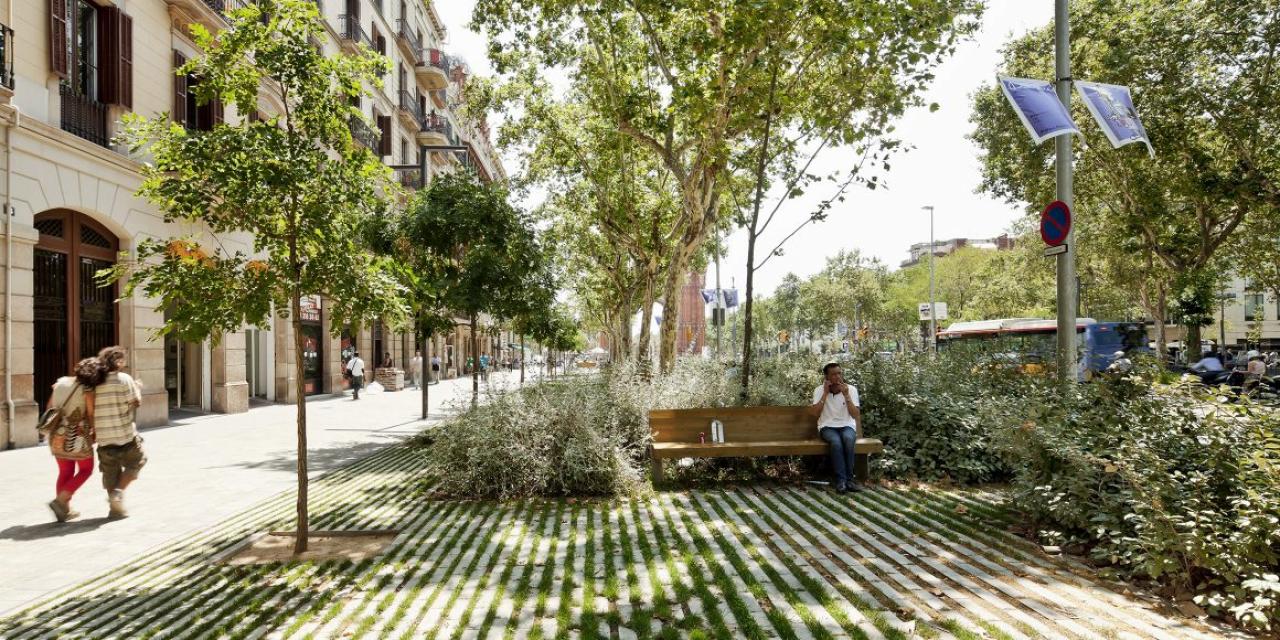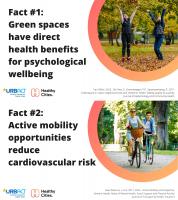
In 1948, the World Health Organisation (WHO) defined health as "a state of complete physical, mental and social well-being and not merely the absence of disease or infirmity".
So, what is a healthy city?
A healthy city is certainly not a city full of hospitals, but a quality environment that facilitates and encourages a full and healthy lifestyle from both a physical and emotional point of view. It is an environment that makes us feel happy; because health and happiness are closely related.
The healthy city is about well-being and quality of life from a holistic perspective, so it involves issues such as public spaces, green areas, facilities, mixed uses, housing, mobility, and more.
It is a incredibly broad, cross-sectional topic with countless interactions between different departments and policy domains beyond urban planning.
Our network has decided to address the challenge from three different but complementary starting points: greening & landscape; connectivity-mobility-accessibility; and impact on lifestyle.
The three subjects are deeply interconnected but have specific aspects that we wish to examine in more detail, which is why these are the topics we have been addressing in our thematic meetings (“deep-dives”) over the last few months.

The first two themes (greening & landscape; connectivity-mobility) are perhaps most obvious in relation to urban planning, but the third (lifestyle) is also very relevant. We are exploring whether the urban environment facilitates or hinders a healthy lifestyle and pointing out the connections between lifestyle and urban planning by analysing and designing streets, public spaces and land use “mixticity” – three key elements in the urban environment that have a great impact on the way we live, move around, interact, and socialise with each other.
It is striking that almost 70% of annual global mortality is attributed to the development of chronic non-communicable diseases (cardiovascular, respiratory, diabetes, cancer, etc.), which have as a common denominator the high prevalence of lifestyle and environmental factors such as lack of physical activity, poor diet and low air quality. In a way, the urban environments we have built for ourselves are killing us by forcing us to live unhealthy lifestyles. It is clear that creating a healthy environment which promotes an active lifestyle has a direct impact on our health.
Normally, animals build their nests according to their needs, protecting themselves from adverse weather conditions or making life easier for themselves in a hostile environment. The materials, the location, the orientation, everything responds to a natural logic: to create a more favourable environment for life.
It is unthinkable that most of our urban environments, “our nests”, are hostile environments that are detrimental to our health and oppose our needs as human beings.
The science behind the concept of a healthy city
The scientific evidence is clear: air quality, noise, lack of green spaces, heat, and lack of physical activity all have an impact on cardiovascular, respiratory, muscular, psychological and reproductive diseases.
Walking briskly for 30 minutes a day reduces the risk of heart attack by 20-30%, diabetes by up to 40%, and depression by 30% (NHS Scotland, 2011). Given this evidence, urban planning must provide the right environment to facilitate this daily physical activity in a comfortable, accessible, and safe way.
Green spaces also have a major impact at different levels. Having a green space less than 500m from home increases physical activity by three times (Coombes, 2010), which is especially relevant considering that 53% of the European population is overweight. Furthermore, it is estimated that air pollution causes 800,000 premature deaths in Europe each year (Netheri R. 2019), and that more than 80% of the urban population breathes air with PM2.5 particulate matter levels above the WHO recommended levels (S.Khomenko, 2021). In addition, worldwide, noise pollution increases the likelihood of cardiovascular disease by 17%, leading to as many as 10,000 premature deaths each year.

If WHO recommendations on physical activity, air quality, noise, heat and access to green spaces were met, an estimated 20% of premature deaths in Barcelona could be prevented each year, saving €9.300 million annually (N.Mueller et.al, 2016).
The evidence is so vast and so clear that forgetting health when planning our urban environments is no longer an acceptable option. It is no longer a matter of faith or will, but a simple and obvious necessity.
The Healthy Cities Network
We are convinced of the scientific evidence and need for healthier environments, which is why the Healthy Cities Network is building a two-way bridge linking scientific evidence and practice (urban planning, urban design, and urban policy).
Firstly, we try to analyse and understand how the urban environment in which we live affects our health, assessing the health impact of urban planning decisions. We use a Health Impact Assessment methodology to develop an Integrated Action Plan and to visualise the impact of this plan on health indicators.
And secondly, we go one step further because mere analysis is not enough. We want to be proactive, so we are exploring how we can improve our health using urban planning as a tool and a driver for change, looking at how best to incorporate the health perspective in the urban planning process and design.
Additionally, we use health as an objective and entry point to plan and design our urban activities.
If there is one thing that is necessary to plan for a healthy city, it is to understand that health is a cross-cutting issue (as WHO defines "health in all policies") and so working in an integrated way is a basic ingredient for success.
This work is also highly interdisciplinary. Our Healthy Cities Network and our local groups involve many different departments and policy domains: urban planning, infrastructure, mobility, greening, air quality, sports, culture, education and of course public health and the health system itself. All the while, we keep the focus on urban planning as the holistic field to bring all of these domains together to help build healthy communities.
Authors:
Marta Rofin Serrà (Project Coordinator)
Sebastiaan van Herk (Lead Expert)
Sofia Aivalioti (Ad-Hoc Expert)

